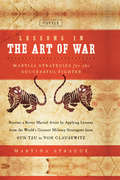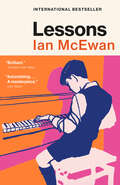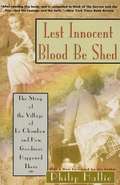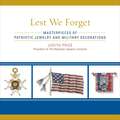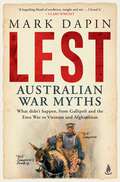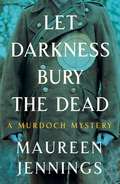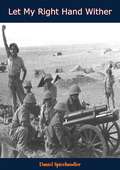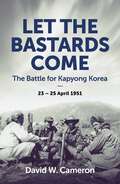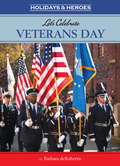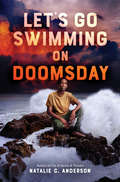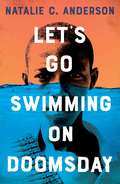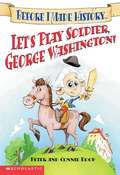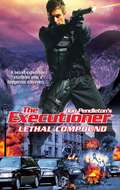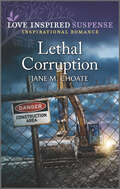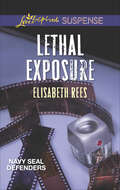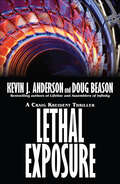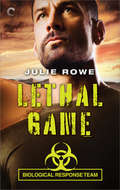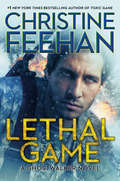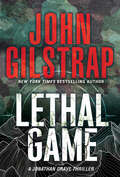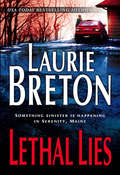- Table View
- List View
Lessons in the Art of War
by Martina SpragueWar is a human activity, not one that is limited by geographic location. And the principles of war are the same, regardless of place or number of participants. An army of ten thousand engaged in battle uses the same basic strategies that two people in single combat will utilize.In Lessons in the Art of War, author Martina Sprague explores the writings of both Sun Tzu, the famous Chinese military strategist, and Carl von Clausewitz, the European military genius. Despite the differences in time period, geographic location and culture, both Sun Tzu and von Clausewitz had achieved extraordinary understanding of human nature and how that relates to combat. Sprague takes the similarities and differences in their respective strategies and distills them down to their essence for martial artists to understand and incorporate into their personal practices.
Lessons: A Novel
by Ian McEwanBoth epic and intimate, the story of one man&’s life across generations and historical upheavals: a deeply affecting novel about love, loss, ambition, and resolution—from #1 bestselling author Ian McEwan.When the world is still counting the cost of the Second World War and the Iron Curtain has closed, eleven-year-old Roland Baines&’s life is turned upside down. 2,000 miles from his mother&’s protective love, stranded at an unusual boarding school, his vulnerability attracts piano teacher Miss Miriam Cornell, leaving scars as well as a memory of love that will never fade.Now, when his wife vanishes, leaving him alone with his tiny son, Roland is forced to confront the reality of his restless existence. As the radiation from Chernobyl spreads across Europe, he begins a search for answers that looks deep into his family history and will last for the rest of his life.From the Suez Crisis to the Cuban Missile Crisis, the fall of the Berlin Wall to the current pandemic and climate change, Roland sometimes rides with the tide of history, but more often struggles against it. Haunted by lost opportunities, he seeks solace through every possible means—music, literature, friends, sex, politics and, finally, love cut tragically short, then love ultimately redeemed. His journey raises important questions for us all. Can we take full charge of the course of our lives without damage to others? How do global events beyond our control shape our lives and our memories? And what can we really learn from the traumas of the past?Epic, mesmerising and deeply humane, Lessons is a chronicle for our times—a powerful meditation on history and humanity through the prism of one man&’s lifetime.
Lest Innocent Blood Be Shed: The Story Of The Village Of Le Chambon And How Goodness Happened
by Philip P. HallieDuring the most terrible years of World War II, when inhumanity and political insanity held most of the world in their grip and the Nazi domination of Europe seemed irrevocable and unchallenged, a miraculous event took place in a small Protestant town in southern France called Le Chambon. There, quietly, peacefully, and in full view of the Vichy government and a nearby division of the Nazi SS, Le Chambon's villagers and their clergy organized to save thousands of Jewish children and adults from certain death.
Lest We Forget: Masterpieces of Patriotic Jewelry and Military Decorations
by Judith PriceSince ancient times, memorable moments of military history have been commemorated with jewelry, medals, and symbolic accessories. In Lest We Forget: Masterpieces of Patriotic Jewelry and Military Decorations, Judith Price illuminates iconic military objects, exploring their origins and documenting their place in history. The dramatic compilation of patriotic jewelry and decorations presented in Price&’s sixth book tells a truly dazzling story of Western historical conflict and resolution.Lest We Forget serves as a stunning tribute to our men and women in service both past and present. This book derives its title from the poem &“Recessional&” by Rudyard Kipling, often used as a tribute in war memorials, while its contents chronicle our military history since the Revolution through 150 iconic artifacts. It showcases such diverse items as the Washington Peace Medals to the Indians, the earliest Medals of Honor, Civil War Corps badges, British military decorations, and historic French treasures. Drawn from leading world museums and private collections such as the British Museum, the West Point Museum, the Musée de l&’Armée, and the Imperial War Museum, the objects depicted in this book movingly recall the role of decorations and jewelry in commemorating war and peace.
Lest: Australian War Myths
by Mark DapinFrom Simpson&’s donkey and the Emu War to Vietnam and Ben Roberts-Smith, Australian military history is full of events that didn&’t happen the way most people think they did. In his inimitable style, award-winning author Mark Dapin sets the record straight. Australia has many stories and statues &‘lest we forget&’ our military past. But from Simpson&’s donkey to Ben Roberts-Smith, our history is full of events that didn&’t happen the way most people think they did. The first Anzac Day, for example, was far from being a solemn march – it was a celebration where people dressed as cavemen and dinosaurs, among other things. And is it true that British officers callously dispatched Australian soldiers to their deaths in the Dardanelles, as we&’ve been told? Did we really hate the soldiers returning from Vietnam? Were the white-feather women of the First World War fact or fiction? In his inimitable style, award-winning author and historian Mark Dapin sets the record straight, showing that the reality was often completely different from the myth – and that in celebrating the wrong people we often overlook the real heroes. &‘With Lest, Mark Dapin transforms his trademark humour into serious history … It forces us to look again at stories we think we all know – or should know – and reframe them with intellectual rectitude and rigour … Lest offers new perspectives on the past from one of Australia&’s most interesting and provocative thinkers.&’ Clare Wright
Let Darkness Bury the Dead
by Maureen JenningsCanada's premier author of historical mystery fiction returns with a brand new and highly anticipated Murdoch Mystery, with an older and wiser Detective Murdoch.It is November 1917. The Great War is grinding on, chewing up young men by the thousands. Initially, in the loyal Dominion of Canada, people are mostly eager to support the Motherland and fight for the Empire. Men perceived as slackers or cowards are shunned. But the carnage is horrendous and with enforced conscription, the enthusiasm for war is dimming. William Murdoch is a widower, a senior detective who, thanks to the new temperance laws, spends his time tracking down bootleggers and tipplers; most unsatisfying. His wife, Amy, died giving birth to their second child, a girl who lived only a few hours more. Murdoch, racked by grief, withdrew from four-year-old, Jack. This he regrets and would dearly love to make up for his negligence. As we enter the story, Jack, now twenty-one, has returned from France after being wounded and gassed at the Battle of Passchendaele. It is soon apparent that he is deeply troubled but he's not confiding in his father. He does, however, seem to be bound by shared secrets to another wounded former soldier, Percy McKinnon. Murdoch suddenly has much more serious crimes than rum-running on his hands. The night after Jack and McKinnon arrive home, a young man is found stabbed to death in the impoverished area of Toronto known as the Ward. Soon after, Murdoch has to deal with a tragic suicide, also a young man. Two more murders follow in quick succession. The only common denominator is that all of the men were exempted from conscription. Increasingly worried that Jack knows more than he is letting on, Murdoch must solve these crimes before more innocents lose their lives. It is a solution that will give him only sorrow.
Let It Destroy You: A Novel
by Harriet Alida LyeInspired by the true story of a dangerous atomic weapon and the man who designed it, here is a stunning novel of morality, creation, and loss from the acclaimed author of The Honey Farm and Natural Killer.It is August 12, 1945. Tomorrow, August Snow will be tried at the International War Crimes Court for patenting a more lethal variation on the atomic bomb. He invented a radiation machine to cure his young daughter&’s cancer, despite knowing that the very same technology was capable of great destruction, and inevitably profited from disaster. But are his intentions relevant when the fate of the world is at stake?August&’s former wife, June, will also attend the hearing. Restless in her Hague hotel room the night before, she keeps watch over their daughter and reflects on the events that brought them here. She had nothing to do with making the bomb. But is she innocent? Wouldn&’t any wife and mother have done the same thing in her shoes? And now, will it cost her everything?Inspired by the physicist Leó Szilárd and the letters he wrote his wife, Gertrud "Trude" Weiss, Let It Destroy You is told in parallel narratives and ventures from Budapest to Berlin to Colorado, and back to Europe. It is a love story about two people whose destinies are bound by everything they share, and all that they&’ve kept from one another. Above all, it is a testament to the logic-defying love of a parent who will stop at nothing to protect their child.
Let My Right Hand Wither
by Daniel SpicehandlerA memoir of the first Arab-Israeli War in 1948 by an American veteran of that conflict and World War Two.“I have tried through my own experiences, first as a G.I. student at the Hebrew University in Jerusalem, and later as a volunteer in the defense of Israel, to depict the life in Israel during the past few crucial years. I have tried to describe the many tremendous changes embroidered in the one major transformation of Palestine, 1946, to Israel, 1949. The underground struggle, the life in the cities and farm communities, the constant preparation for the eventuality of a war which every Jew in Palestine knew was inevitable, the early struggle against local Arab gangs, and finally, the struggle against the seven invading Arab armies.The events in this book are true.Through the events that my wife, some friends and myself, all Americans, have participated in, I have tried to paint a picture of the rebirth of Israel, spiritually as well as physically. And I have taken the liberty of injecting, throughout the text, small incidents in which I had no active part, but of which I have heard or read. These incidents typify the fighting and living in Israel during these fateful years. They are included in the hope that they will contribute to a better understanding of the new Jew, the Sabra, who is growing up with Israel.The American reader, I am sure, will notice the close resemblance of the youth of Israel to his own youth. The former G.I. will be amazed to see how closely the “Palmachnick” resembles him in the last war. And the scene of Palestine, and later Israel, as a frontier country, will remind Americans of the struggle America once had in its fight for independence.”—From the Introduction.
Let Us March On: A Novel
by Shara MoonDevoted wife, White House maid, reluctant activist…A stirring novel inspired by the life of an unsung heroine, and real-life crusader, Lizzie McDuffie, who as a maid in FDR’s White House spearheaded the Civil Rights movement of her time.I’m just a college-educated Southerner with a passion for books. My husband says I’m too bold, too sharp, too unrelenting. Others say I helped spearhead the Civil Rights movement of our time. President Roosevelt says I’m too spunky and spirited for my own good.Who am I?I am Elizabeth “Lizzie” McDuffie. And this is my story…When Lizzie McDuffie, maid to Eleanor and Franklin D. Roosevelt, boldly proclaimed herself FDR’s “Secretary-On-Colored-People’s-Affairs,” she became more than just a maid—she became the President’s eyes and ears into the Black community. After joining the White House to work alongside her husband, FDR’s personal valet, Lizzie managed to become completely indispensable to the Roosevelt family. Never shy about pointing out injustices, she advocated for the needs and rights of her fellow African Americans when those in the White House blocked access to the President.Following the life of Lizzie McDuffie throughout her time in the White House as she championed the rights of everyday Americans and provided access to the most powerful man in the country, Let Us March On looks at the unsung and courageous crusader who is finally getting the recognition she so richly deserves.
Let the Bastards Come: The Battle for Kapyong Korea, 23 – 25 April 1951
by David W. CameronAnzac Day 2024 represents the 73rd anniversary of the critical battle of Kapyong (23 to 25 April 1951) This book for the first time tells the full story of the Australian, Canadian, New Zealand and American units involved. Fewer than 1,000 Australian and Canadian infantrymen, supported by New Zealand artillery and 15 American Sherman tanks fought off an entire Chinese Division of over 12,000 men and contributed significantly to defeating the great Chinese August offensive. The battle of Kapyong was fought during a heavy downpour in mountainous terrain, with Chinese units infiltrating the Australian lines which extended for seven kilometres. Given the small number of men involved and the long defensive line, several strong points were quickly established. The Australians almost alone, but with support from New Zealand gunners and some American tanks, for the first 24 hours held back the Chinese and were at times surrounded by large numbers of Chinese who launched ongoing human wave attacks against their isolated positions — but the line held with Australians leading bayonet counter charges against the Chinese. Within 24 hours, Canadian troops were committed to the battle and for 12 hours also faced significant attempts by the Chinese to surround their position – they too held their ground. The battle of Kapyong was truly a decisive battle of the Korean War, and for their heroic actions during the battle of Kapyong, the Australian and Canadian infantrymen and American tankers were awarded a rare US Presidential Unit citation.
Let the Spacemen Beware
by Poul AndersonTo the men of the starship Quetzal their task seemed routine: to establish diplomatic relations and enter into trade negotiations with the people of a newly discovered planet. Since to all appearances the folk of Gwydion were the most thoroughly amiable in all the galaxy - words for such concepts as war, theft, anger, murder and jealousy did not even exist in their language - there could hardly be a problem. But as the season changed on Gwydion, so did the people...
Let's Celebrate Veterans Day (Holidays & Heros)
by Barbara deRubertisWho is a veteran? By exploring the kinds of work that men and women do as they serve in the five branches of the military, we can better appreciate our veterans. And we discover some of the many reasons we honor and celebrate them each year on November 11.
Let's Go Swimming on Doomsday
by Natalie C. AndersonForced to become a child soldier, a sixteen-year-old Somali refugee must confront his painful past in this haunting, thrilling tale of loss and redemption for fans of A Long Way Gone and What is the What When Abdi's family is kidnapped, he's forced to do the unthinkable: become a child soldier with the ruthless jihadi group Al Shabaab. <P><P>In order to save the lives of those he loves, and earn their freedom, Abdi agrees to be embedded as a spy within the militia's ranks and to send dispatches on their plans to the Americans. The jihadists trust Abdi immediately because his older brother, Dahir, is already one of them, protégé to General Idris, aka the Butcher. If Abdi's duplicity is discovered, he will be killed. <P><P>For weeks, Abdi trains with them, witnessing atrocity after atrocity, becoming a monster himself, wondering if he's even pretending anymore. He only escapes after he is forced into a suicide bomber's vest, which still leaves him stumps where two of his fingers used to be and his brother near death. Eventually, he finds himself on the streets of Sangui City, Kenya, stealing what he can find to get by, sleeping nights in empty alleyways, wondering what's become of the family that was stolen from him. <P><P>But everything changes when Abdi's picked up for a petty theft, which sets into motion a chain reaction that forces him to reckon with a past he's been trying to forget. In this riveting, unflinching tale of sacrifice and hope, critically-acclaimed author Natalie C. Anderson delivers another tour-de-force that will leave readers at the edge of their seats.
Let's Go Swimming on Doomsday
by Natalie C. AndersonI tell myself I&’ve chosen to live, but the water knows the truth. Waves brush my arms, soft as shroud linen. The water knows I have to die. Three years after his older brother is recruited by the Somali militia group Al Shaabab, Abdi and his family are kidnapped by Americans. In exchange for their freedom, he reluctantly agrees to go undercover to rescue his brother and help foil deadly attacks. After months in their ranks, Abdi finally escapes. Haunted and alone on the streets of Kenya, he steals what he can to get by. But an arrest for petty theft sets in motion a chain of events that force him to confront the past he&’s been so desperately trying to forget.
Let's Play Soldier, George Washington! (Before I Made History)
by Peter Roop Connie RoopWhat you might not know is that: General Washington led our American army to victory in the Revolutionary War. President Washington was our first President. George Washington had no children of his own. George Washington fought a war so Americans could be free. We celebrate George Washington's birthday in February on Presidents' Day. But did you know George Washington really had two birthdays? George Washington's face is on every dollar bill.
Lethal Compound
by Don PendletonU. S. intelligence agents become aware of a wealthy American's plans only when they intercept the chatter of Chinese spies. It is the billionaire's intention to lead a secret archaeological expedition into the mountainous border triangle between Afghanistan, China and Tajikistan. Mack Bolan is inserted within the group as they head into an area that is a hotbed of opium production. Traveling undercover with a group of foreign mercenaries hired to act as private security, Bolan knows that priceless treasure isn't the only thing hidden in the mountains of Tajikistan. And when they come under attack by Russian fighter jets, it becomes apparent to the Executioner that the unstable region is about to blow.
Lethal Corruption
by Jane M. ChoateA major case places an ambitious attorney’s life in danger in this inspirational romantic suspense thriller.Nothing will stop deputy district attorney Shannon DeFord from prosecuting the biggest case of her career—not even a warning at knifepoint. Unsure of who to trust, she accepts security expert Rafe Zuniga’s daily protection. But when the threats turn deadly, they both know this is more than a typical criminal trial. Together, can they unravel a conspiracy . . . or will the truth get them killed?From Love Inspired Suspense: Courage. Danger. Faith.
Lethal Exposure (Navy SEAL Defenders)
by Elisabeth ReesAn ex-Navy SEAL leaps into action to protect a photographer and her children from harm in this inspirational romantic suspense adventure.When single mother and photographer Rebecca Grey’s home is invaded, she calls former Navy SEAL Conrad “Jack” Jackson. Though she’d never betray her late husband’s memory by falling for his fellow soldier, she’s desperate for Jack’s help. Rebecca is in possession of photos that can expose a plot to sell priceless artwork stolen from a Middle Eastern palace. Now a dangerous enemy wants her to either surrender the pictures . . . or her life. Jack promised his best friend he’d lay down his life for Rebecca and her daughters. And as the danger lurks ever closer, that’s just what he may have to do to save her.“This tale gets off to a dramatic and tense start. Complex characters combine with strong writing in this totally entertaining suspense.” —RT Book Reviews
Lethal Exposure (The Craig Kreident Thrillers)
by Kevin J. Anderson Doug BeasonAt Fermilab near Chicago, researchers use the world’s largest particle accelerator to unlock the secrets of the subatomic universe. While working late one night, Dr. Georg Dumenico—candidate for the Nobel Prize in physics—is bombarded with a lethal exposure of radiation. He will die horribly within days. FBI Special Agent Craig Kreident knows it was no accident—but he has to prove it, and the clock is ticking. The nation’s most valued research is at stake, and only Dumenico himself knows enough to track down his own murderer…if he survives long enough to do it.
Lethal Game
by Julie RoweBook two of Biological Response TeamAs the nation's youngest virologist and hematologist, Captain Sophia Perry has always been one step ahead of her peers. But there's one thing she can't beat--cancer. She wants to make a difference in the time she has left, so when she's sent to investigate a breakout at a Syrian refugee camp, she goes, saying nothing of her diagnosis. But saving the masses isn't easy when the man tasked to protect her is so irresistible.Communications Sergeant Connor Button is back on active duty after a deadly explosion, but he doesn't feel whole again until he meets Sophia. Assigned to keep her safe, he's prepared to die for her, but for the first time in months he truly wants to live--if only she wasn't so determined to put them both in danger.With a secret to keep and nothing to lose, Sophia is determined to find the source of the breakout at any cost. Violent attacks on the camp convince her that someone wants her to pay dearly. But as Sophia's health deteriorates, Connor must find a way to help her defeat her enemies before her body defeats her.72,000 words
Lethal Game (A GhostWalker Novel #16)
by Christine FeehanThe sparks of unexpected passion ignite in this electrifying GhostWalker novel from #1 New York Times bestselling author Christine Feehan. When Malichai Fortunes attacks a problem, he does it full force—a habit that earns the GhostWalker a painful injury and a forced vacation in San Diego, California. <P><P>With nothing but physical therapy on the horizon, Malichai is starting to get restless...until a striking blue-eyed blonde makes all his senses come alive. Amaryllis is kind and warm and sees beyond Malichai’s rough exterior, but he can tell there’s something she’s hiding. Her innate healing abilities indicate she might be a GhostWalker—albeit an untrained one. <P><P>Malichai doesn’t think their paths crossing is anything more than coincidence, but he can sense that one wrong word could send Amaryllis running. <P><P>When strange events at his temporary retreat put Malichai on high alert, he knows he won&’t be able to deal with the threat and keep his woman safe in his weakened state. But calling in his brothers means telling Amaryllis what he really is, and revealing that he knows the truth about her too.… <P><P><b>A New York Times Bestseller</b>
Lethal Game: A Riveting Black Ops Thriller (A Jonathan Grave Thriller #14)
by John Gilstrap&“[Gilstrap&’s] greatest strength is the ability to blend breathtaking action with deep emotion regarding the characters.&” —Jeffery DeaverThe exhilarating new thriller from the New York Times and USA Today bestselling author takes readers on an action-packed thrill ride from the wilds of Montana to the streets of Mexico, as a sniper attack turns wilderness hunters into the hunted and Grave&’s enemies stalk him with a vengeance… Hostage rescue expert Jonathan Grave and his fellow special-ops veteran, Boxers, are hunting in Montana when shots ring out, and they realize they&’ve become the prey for assassins. In the crosshairs of unseen shooters, cut off from all communication, with the wind at a blood-freezing chill, the nightmare is just beginning. Because Jonathan and Boxers aren&’t the only ones under fire. Back in Fisherman&’s Cove, Virginia, Jonathan&’s Security Solutions team is fighting for their lives too. A vicious onslaught is clearing the way for a much bigger game by eliminating anyone in the way. If Jonathan and Boxers can make it out of the wilderness alive, the real war will begin. "When you pick up a John Gilstrap novel one thing is always true, you are going to be entertained at a high rate of speed." —Suspense Magazine &“Fans of adventure stories will find plenty to like.&” —Publishers Weekly
Lethal Lies
by Laurie BretonChelsea Logan never gets the chance to file the storythat would have shocked the blue-collar town ofSerenity, Maine, to its core. Her death is ruled asuicide, but her cousin Faith Pelletier knows Chelseabetter than that. Faith returns to their hometown andbegins to ask questions-questions that no one wantsto answer. And it’s not long before she uncovers somenasty little truths about life in this fading mill town.As Faith closes in on a web of drugs and violence,she is forced to turn to police chief Ty Savage forinformation. After all these years he still gets underher skin, but should she trust him? As the circle ofdeceit draws ever tighter, Faith must outwit a facelessenemy who will stop at nothing to have her silenced.
Lethal Lies (Blood Brothers #2)
by Rebecca ZanettiA deadly secret can't stay buried forever . . . Revenge. It's the only thing that will help Anya Best sleep at night. The serial killer who murdered her sister is on the loose, and Anya will stop at nothing to put him behind bars-even use herself as bait to lure him out of hiding. But she can't do this alone.Private investigator Heath Jones's job is to bring bastards to justice. This time it's personal. He knew the Copper Killer's latest victim so when her sister asks for his help, he's all in. But when Anya uses the media to taunt the killer, she exposes Heath's identity, putting them both in jeopardy. Now, secrets buried long ago are coming to light and the forces determined to destroy him are watching Heath's every move, waiting to exact their own revenge. And they'll use anything and anyone to get to Heath.With twists and turns that will take your breath away, LETHAL LIES is sexy, action-packed suspense at its very best from New York Times bestselling author Rebecca Zanetti.
Lethal Nights: A Brute Force Novel (Brute Force #3)
by Lora Leigh#1 bestselling author Lora Leigh turns up the heat in her latest novel of high-stakes passion and persuasion featuring the men of Brute Force.Ilya Dragonovich is no stranger to the dark side. As a safe-house owner for security agency Brute Force, Dragon knows that the battle line between good and evil runs through the heart of every man—and, sometimes, a beautiful woman…Emma Jane Preston needs help. After her marriage crumbled, she believed she could get back to a normal, happy life. But now she needs the kind of protection that comes at a cost—one that only someone like Dragon can provide. But can Emma Jane trust this handsome, undercover operator to keep her safe when she is in danger of falling into the arms of the deeply seductive, fiery Dragon. . .and never letting go?“Leigh’s books can scorch the ink off the page.”—RT Book Reviews
